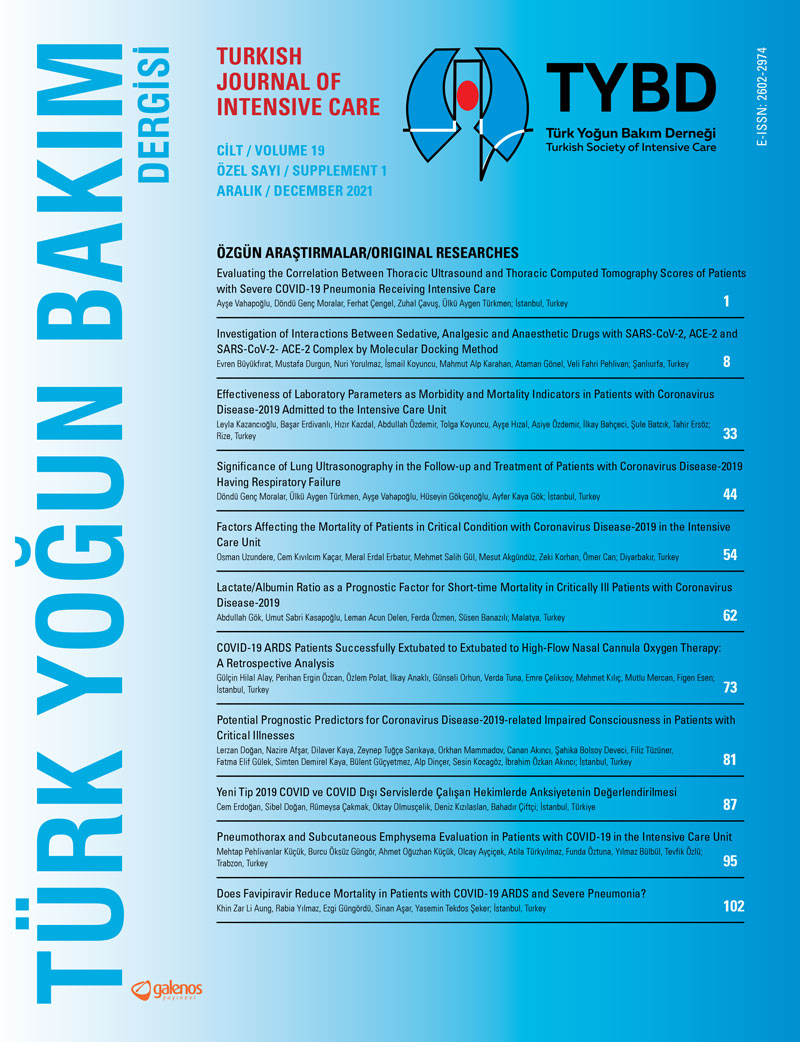Abstract
Objective:
Central nervous system involvement in patients with coronavirus disease-2019 (COVID-19) is associated with increased morbidity and mortality. The assessment of neurological symptoms in patients with critical illnesses, who are mechanically ventilated under deep sedation is challenging, which means doctors could be unaware of such symptoms until patients reach the weaning stage. Thus, this study aimed to identify potential prognostic predictors for COVID-19-related impaired consciousness in patients with critical illnesses.
Materials and Methods:
This retrospective, multicenter, and observational cohort study was conducted among patients with COVID-19 who were admitted to the intensive care units of five hospitals between March 11, 2020, and September 18, 2020. The patient population was analyzed in two groups-cases with impaired consciousness and cases without impaired consciousness.
Results:
Patients with impaired consciousness were found to be significantly younger (p=0.001) and to exhibit significantly more laboratory abnormalities, such as high ferritin (p=0.003), C-reactive protein (p=0.001), procalcitonin (p=0.019), and D-dimer (p=0.001) levels. Additionally, pathological magnetic resonance imaging findings were detected in 14 of 29 (48%) patients with impaired consciousness.
Conclusion:
All patients with severe COVID-19 should be screened for signs of hyperinflammation due to the associated risk of neurological complications. The early detection of at-risk cases and the prompt initiation of specific treatment should result in better disease outcomes.
Keywords: COVID-19, neurological complications, inflammatory markers, hyperinflammation
References
- Helms J, Kremer S, Merdji H, Clere-Jehl R, Schenck M, Kummerlen C, et al. Neurologic Features in Severe SARS-CoV-2 Infection. N Engl J Med 2020;382:2268-70.
- Kandemirli SG, Dogan L, Sarikaya ZT, Kara S, Akinci C, Kaya D, et al. Brain MRI Findings in Patients in the Intensive Care Unit with COVID-19 Infection. Radiology 2020;297:E232-5.
- Dogan L, Kaya D, Sarikaya T, Zengin R, Dincer A, Akinci IO, et al. Plasmapheresis treatment in COVID-19-related autoimmune meningoencephalitis: Case series. Brain Behav Immun 2020;87:155-8.
- Kaur SP, Gupta V. COVID-19 Vaccine: A comprehensive status report. Virus Res 2020;288:198114.
- Sanders JM, Monogue ML, Jodlowski TZ, Cutrell JB. Pharmacologic Treatments for Coronavirus Disease 2019 (COVID-19): A Review. JAMA 2020;323:1824-36.
- Alhazzani W, Møller MH, Arabi YM, Loeb M, Gong MN, Fan E, et al. Surviving Sepsis Campaign: Guidelines on the Management of Critically Ill Adults with Coronavirus Disease 2019 (COVID-19). Crit Care Med 2020;48:e440-69.
- Bykowski J, Kruk P, Gold JJ, Glaser CA, Sheriff H, Crawford JR. Acute pediatric encephalitis neuroimaging: single-institution series as part of the California encephalitis project. Pediatr Neurol 2015;52:606-14.
- Mehta P, McAuley DF, Brown M, Sanchez E, Tattersall RS, Manson JJ; HLH Across Speciality Collaboration, UK. COVID-19: consider cytokine storm syndromes and immunosuppression. Lancet 2020;395:1033-4.
- Baig AM, Khaleeq A, Ali U, Syeda H. Evidence of the COVID-19 Virus Targeting the CNS: Tissue Distribution, Host-Virus Interaction, and Proposed Neurotropic Mechanisms. ACS Chem Neurosci 2020;11:995-8.
- Rosário C, Zandman-Goddard G, Meyron-Holtz EG, D’Cruz DP, Shoenfeld Y. The hyperferritinemic syndrome: macrophage activation syndrome, Still’s disease, septic shock and catastrophic antiphospholipid syndrome. BMC Med 2013;11:185.
- Agmon-Levin N, Rosário C, Katz BS, Zandman-Goddard G, Meroni P, Cervera R, et al. Ferritin in the antiphospholipid syndrome and its catastrophic variant (cAPS). Lupus 2013;22:1327-35.
- Meisner M. Update on procalcitonin measurements. Ann Lab Med 2014;34:263-73.
- Castelo-Branco C, Soveral I. The immune system and aging: a review. Gynecol Endocrinol 2014;30:16-22.
Copyright and license
Copyright © 2021 The Author(s). This is an open access article distributed under the Creative Commons Attribution License (CC BY), which permits unrestricted use, distribution, and reproduction in any medium or format, provided the original work is properly cited.






















